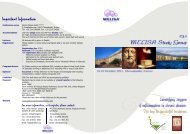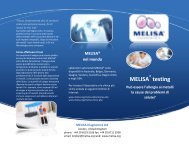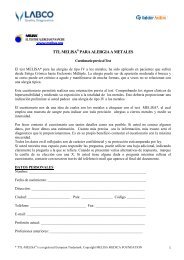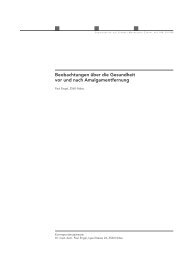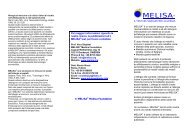The MELISA® test - MELISA Medica Foundation
The MELISA® test - MELISA Medica Foundation
The MELISA® test - MELISA Medica Foundation
Create successful ePaper yourself
Turn your PDF publications into a flip-book with our unique Google optimized e-Paper software.
BIOHELLENICA June 2012<br />
<strong>The</strong> <strong>MELISA</strong>® <strong>test</strong><br />
A revolutionary blood <strong>test</strong> used to improve diagnosis and<br />
treatment of chronic disease<br />
A licensing opportunity for<br />
Biohellenica<br />
<strong>The</strong> <strong>MELISA</strong>® <strong>test</strong> provides important information for patients suffering<br />
from chronic degenerative diseases, including chronic fatigue syndrome<br />
(CFS), fibromyalgia and multiple sclerosis (MS). It is virtually impossible to<br />
avoid exposure to environmental pollutants, such as metals like nickel,<br />
mercury and titanium. <strong>The</strong> most common sources of exposure are dental<br />
materials, orthopedic implants and food additives.<br />
With increasing awareness about the possible side-effects from metal<br />
exposure in sensitive individuals comes a growing demand for the<br />
<strong>MELISA</strong>® <strong>test</strong> across the world. In Greece we work with several clinics that<br />
send patients for <strong>MELISA</strong>® <strong>test</strong>ing abroad, but the time and cost for<br />
transport limits the demand.<br />
Metal allergy plays an<br />
important role in a variety of<br />
medical specialties, such as:<br />
• Orthopedics and<br />
implants<br />
• Dentistry<br />
• Occupational medicine<br />
and environmental<br />
health<br />
• Diseases of<br />
immunologic origin<br />
• Infectious diseases<br />
All licensed <strong>MELISA</strong>® laboratories receive access to our contact network<br />
and comprehensive marketing support; from ready-made marketing<br />
materials to constant exposure through our website www.melisa.org and<br />
through lectures and international conferences.<br />
“Our case demonstrated the need for proper investigation with <strong>test</strong>s such<br />
as <strong>MELISA</strong>® and also the need for proper history in all such patients.”<br />
Orthopaedic surgery in a patient with metal sensitivity.<br />
Adala R et al. Aesthet Surg. 2011 Jan-Apr; 4(1): 67-68.
BIOHELLENICA June 2012<br />
<strong>The</strong> effect of metals on health<br />
<strong>The</strong> adverse effect metals may have on human<br />
health is a growing area of research and a<br />
connection between metals and the onset or<br />
worsening of symptoms has been documented<br />
by both clinics and in peer reviewed literature.<br />
Metal allergy is usually diagnosed by patch<br />
<strong>test</strong>ing, but this can be problematic when<br />
<strong>test</strong>ing irritative substances as mercury, or<br />
substances with large particles like titanium<br />
dioxide. Using <strong>MELISA</strong>® avoids many of<br />
obstacles of patch <strong>test</strong>ing.<br />
Chronic exposure to metals in jewellery, dental<br />
implants and restorations, cosmetics or joint<br />
prostheses can sensitize genetically<br />
predisposed individuals and induce a so-called<br />
Type IV allergic reaction (cellular type<br />
hypersensitivity).<br />
Metals are potential allergens. <strong>The</strong> binding of<br />
metal ions to proteins can alter the protein<br />
activity and surface structure of these<br />
enzymes, thereby inducing local or systemic<br />
symptoms characteristic of allergic reactions or<br />
autoimmune diseases.<br />
In contrast to a Type I allergy, which is<br />
mediated by IgE antibodies, a Type IV allergic<br />
reaction is mediated by T lymphocytes that<br />
have had prior contact to a given allergen<br />
(memory lymphocytes). Following renewed<br />
contact with the sensitizing allergen, these<br />
memory lymphocytes respond by enlarging<br />
(lymphoblast transformation) and dividing<br />
(proliferation). <strong>The</strong> newly formed cells (effector<br />
cells) together with their secreted cytokines<br />
mediate the resulting inflammatory reaction.<br />
It is important to differentiate between<br />
metal allergy and metal toxicity. <strong>The</strong><br />
<strong>MELISA</strong>® <strong>test</strong> does not measure the levels of<br />
metals in a patient’s body; it measures whether<br />
the patient is allergic to metals. For example,<br />
hair samples may show levels of mercury or<br />
other substances which are below the official<br />
“safe limit” – but the patient can still be<br />
allergic. For allergic individuals, there is no such<br />
thing as a “safe” limit. Even a minute amount of<br />
a substance may pose danger in an allergic<br />
individual.<br />
A well-known allergen, nickel is present<br />
in some dental materials and nickelcontaining<br />
alloys. Such exposure can<br />
cause serious health problems in nickelallergic<br />
patients. Nickel is also present in<br />
cheap jewelry and many household<br />
items. Nickel-allergic patients may<br />
benefit from a low nickel diet, mainly<br />
avoiding foods such as nuts, beans and<br />
oats.<br />
2
BIOHELLENICA June 2012<br />
Orthopedic surgery and implants<br />
Metals are found in body implants such as hip joints,<br />
knee prosthesis, screws, pacemakers, silicone breast<br />
implants, cochlear implants and dental implants. In the<br />
majority of patients, these implants are biocompatible.<br />
However, in sensitive patients, the implants may<br />
induce side-effects such as pain, dermatitis, cutaneous<br />
swelling, impaired wound healing, bone infections and<br />
implant loosening. Less knows is that even excessive<br />
fatigue can be due to chronic inflammation due to<br />
metal ions.<br />
Although bacterial infection is often the cause of<br />
implant rejection, sometimes no bacteria are detected<br />
despite of inflammation. <strong>The</strong>se adverse effects are<br />
mediated by so called wearing products of implant<br />
materials. Nickel, cobalt and chromium are known<br />
metal allergens.<br />
Recently, the cases of titanium allergy have also been<br />
described in the literature. Titanium is a transition<br />
metal and thus may function as a hapten and trigger<br />
cellular hypersensitivity. Since titanium is used as white<br />
pigment in toothpaste, cosmetics and medicaments,<br />
the sensitization of susceptible individuals is possible.<br />
Dentistry<br />
Mucosal changes around dental metal fillings such as<br />
oral lichen may be due to an allergic reaction to the<br />
metal component. Replacement of fillings in metalsensitive<br />
patients leads to disappearance of the<br />
symptoms (Prochazkova et al. 2004).<br />
Allergic reactions to metals used in dental prosthesis,<br />
implants (for example titanium implants, see picture<br />
above right) and braces can be measured in the<br />
<strong>MELISA</strong>® <strong>test</strong>. Symptoms may not always be local but<br />
can be systemic and include inflammation in different<br />
body parts.<br />
Occupational medicine and<br />
environmental health<br />
<strong>The</strong> <strong>MELISA</strong>® <strong>test</strong> can be used to screen workers who<br />
are exposed to metals, chemicals or other allergens at<br />
work. If sensitivity is detected, the worker should be<br />
placed in an allergen-free environment to avoid the<br />
development of sometimes serious diseases.<br />
In the case of berylliosis, a sarcoidosis-like disease, a<br />
beryllium-specific blood <strong>test</strong> is used as a golden<br />
standard by US industry to screen workers for allergy<br />
against beryllium. It has been found that asymptomatic<br />
workers with memory cells to beryllium will - if<br />
beryllium exposure continues - develop a serious lung<br />
disease. This will not happen if asymptomatic<br />
beryllium-sensitized workers are relocated to a<br />
beryllium-free environment. In addition to lifelong<br />
suffering, considerable savings in sick leave costs are<br />
obtained. Certain occupations pose a special risk for<br />
inducing metal allergy. <strong>The</strong>se include construction<br />
workers, miners, electricians, rubber/wood/paper/<br />
textile industry workers, dentists, hairdressers and<br />
painters.<br />
Patients with known clinical metal sensitivity such as<br />
adverse reactions to gold and nickel containing<br />
earrings should consider non-metallic restorative<br />
materials.<br />
3
BIOHELLENICA June 2012<br />
Diseases of immunologic origin<br />
Metal allergy is common in patients with various diseases such as skin<br />
diseases (psoriasis, eczema), autoimmune diseases (Multiple Sclerosis,<br />
thyroiditis, Sjögren’s disease) and gastroin<strong>test</strong>inal diseases. Patients with<br />
symptoms of profound fatigue of unclear etiology (Chronic Fatigue<br />
Syndrome, Myalgic Encephalitis) often suffer from metal allergy induced<br />
by dental metals. Candida allergy, drug allergy (such as penicillin allergy)<br />
and allergy to chemicals (such as formaldehyde) can also be <strong>test</strong>ed. Metal<br />
allergy has also been implicated in autistic disorders and allergy against<br />
thimerosal (a mercury preservative in vaccines) can be detected by the<br />
<strong>MELISA</strong>® <strong>test</strong>.<br />
Avoidance of allergens often results in significant health improvement of<br />
the patient. Follow-up <strong>MELISA</strong>® <strong>test</strong>ing usually shows reduced<br />
lymphocyte reactivity as well.<br />
Diagnosis of active Lyme Borreliosis<br />
A recent development of the <strong>MELISA</strong>® <strong>test</strong> involves diagnosis of Lyme<br />
disease / active Borreliosis. Standard laboratory <strong>test</strong>ing includes the<br />
serological <strong>test</strong> ELISA, which has very low specificity, and the Western<br />
blot, which is very specific. <strong>The</strong>se <strong>test</strong>s can give false negative results in<br />
patients with early disease and therefore a misdiagnosis can occur.<br />
<strong>MELISA</strong>® detects cellular immuno reactivity of active infections of Borrelia<br />
burgdorferi . <strong>The</strong> <strong>test</strong> improves laboratory diagnosis by confirming an<br />
active infection in patients with or without clinical symptoms.<br />
Further applications<br />
<strong>MELISA</strong>® can also <strong>test</strong> for allergy to gluten, gliadin and casein, and <strong>test</strong>ing<br />
to other food substances is being developed.<br />
<strong>MELISA</strong>® <strong>test</strong><br />
procedure<br />
Blood in citrate tubes must<br />
arrive to the laboratory<br />
optimally within 24 hours after<br />
the blood has been drawn,<br />
maximally within 48 hours.<br />
White blood cells (lymphocytes)<br />
are isolated and <strong>test</strong>ed against<br />
allergens chosen accordingly to<br />
the patient’s anamnesis and<br />
exposure to metals. A<br />
questionnaire, which goes<br />
through the most common<br />
sources of metal exposure, is<br />
available for download at<br />
www.melisa.org. <strong>The</strong> blood is<br />
incubated for five days and the<br />
lymphocyte reaction is measured<br />
by ways: one based on the<br />
uptake of radioisotope by<br />
dividing lymphocytes; the other<br />
by evaluation by microscopy.<br />
<strong>The</strong> level of reactivity is<br />
measured as a Stimulation Index<br />
(SI). A value over 3 indicates a<br />
positive reaction to a given<br />
allergen. <strong>The</strong> results are<br />
available in ten days.<br />
4
BIOHELLENICA June 2012<br />
Licensing of the <strong>MELISA</strong>® <strong>test</strong><br />
Certified laboratories may perform the <strong>MELISA</strong>® <strong>test</strong> under a license agreement. <strong>The</strong><br />
<strong>MELISA</strong>® <strong>test</strong> is protected by trademark. Currently, laboratories performing the <strong>test</strong> are<br />
found Australia, Belgium, Germany, South Africa, Spain, Switzerland, United Kingdom<br />
and USA.<br />
Laboratory equipment and material needed for<br />
<strong>MELISA</strong>® <strong>test</strong>ing<br />
Cytocentrifuge<br />
CO 2 incubator<br />
Table centrifuge for spinning of 50 ml falcon tubes<br />
Betacounter for counting of radioactivity on filters<br />
Harvester for DNA<br />
Different multipipettes<br />
Sterile bench (Laminoflow)<br />
Microscope for light microscopy incl. objective 25x and<br />
40x<br />
Invert microscope (optional)<br />
Water bath<br />
<strong>The</strong> <strong>test</strong>ing requires disposable material such as cell<br />
media, human serum, radioactive thymidine, plastic<br />
ware (pipettes, tubes, plates), metals solutions etc.<br />
5
BIOHELLENICA June 2012<br />
Case study<br />
Sue Collins was 10 years old when her first amalgam fillings<br />
were placed. She suffered from urticaria and rashes<br />
throughout her teenage years and suspected nickel allergy.<br />
As an adult, she underwent tubal ligation with a metal clip.<br />
She developed gallstones and had gall bladder removed.<br />
After placement of dental metal crowns, she experienced<br />
intense abdominal pains and was diagnosed with Irritable<br />
Bowel Syndrome. Additional crowns and bridgework were<br />
fitted and she experienced increasing muscle pain and<br />
weakness. Finally she received the diagnosis of<br />
fibromyalgia and chronic fatigue syndrome. <strong>The</strong> <strong>MELISA</strong> ®<br />
<strong>test</strong> showed a positive reaction to several metals in found<br />
in her dental restoration and metallic clips. After having the<br />
metals removed, her oral symptoms, IBS and fibromyalgia<br />
disappeared.<br />
“I can honestly say I feel like a<br />
new person;<br />
I have my life back.“<br />
Reference literature<br />
Some articles are available from www.melisa.org/articles.php<br />
Hypersensitivity reactions to metallic implants - diagnostic<br />
algorithm and suggested patch <strong>test</strong> series for clinical use.<br />
Schalock PC et al, Contact Dermatitis. 2012 Jan;66(1):4-19.<br />
Orthopaedic surgery in a patient with metal sensitivity.<br />
Adala R, Chakravarthy M, Srinivas V, Pai S. J Cutan Aesthet<br />
Surg. 2011 Jan-Apr; 4(1): 67-68.<br />
Metal allergens of growing significance: epidemiology,<br />
immunotoxicology, strategies for <strong>test</strong>ing and prevention.<br />
Forte G, Petrucci F, Bocca B. Inflamm Allergy Drug Targets.<br />
2008 Sep;7(3):145-62.<br />
<strong>The</strong> role of environmental factors in autoimmune<br />
thyroiditis. Hybenova M, Hrda P, Procházková J, Stejskal V,<br />
Sterzl I. Neuro Endocrinol Lett. 2010;31(3):283-9.<br />
LTT-<strong>MELISA</strong> ® is clinically relevant for detecting and<br />
monitoring metal sensitivity. Valentine-Thon E, Müller K,<br />
Guzzi G, Kreisel S, Ohnsorge P, Sandkamp M. Neuro<br />
Endocrinol Lett 2006; 27(Suppl 1): 17-24<br />
Hypersensitivity to titanium: Clinical and laboratory evidence.<br />
Müller K, Valentine-Thon E. Neuro Endocrinol Lett 2006;<br />
27(Suppl 1): 31-35<br />
Validity of <strong>MELISA</strong> ® for metal sensitivity <strong>test</strong>ing. Valentine-<br />
Thon E., et. al, Neuroendocrinology Letters,<br />
2003;24(1/2):57–64<br />
A novel lymphocyte transformation <strong>test</strong> (LTT-<strong>MELISA</strong> ) for<br />
®<br />
Lyme borreliosis. Valentine-Thon E et al., Diagn Microbiol Infect<br />
Dis. 2006 Jul 27<br />
<strong>MELISA</strong> Diagnostics Limited<br />
Diagnosis and treatment of metal-induced side-effects. Stejskal<br />
V, Hudecek R, Stejskal J, Sterzl I. Neuro Endocrinol Lett 2006;<br />
27(Suppl 1): 7-16<br />
<strong>The</strong> role of metals in autoimmunity. Stejskal J, Stejskal V.<br />
Neuroendocrinology Letters 1999; 20:351-364<br />
Metal-specific lymphocytes: biomarkers of sensitivity in man.<br />
Stejskal, V, et al. Neuroendocrinology Letters 1999; 20:289-<br />
298<br />
Removal of dental amalgam and other metal alloys<br />
supported by antioxidant therapy alleviates symptoms and<br />
improves quality of life in patients with amalgam-associated<br />
ill health. Lindh U, Hudecek R, Danersund A, Eriksson S,<br />
Lindvall A. Neuro Endocrinol Lett. 2002;23(5-6):459-82.<br />
Nickel allergy is found in a majority of women with chronic<br />
fatigue syndrome and muscle pain - and may be triggered by<br />
cigarette smoke and dietary nickel intake. Regland B,<br />
Zachrisson O, Stejskal V, Gottfries CG. Journal of Chronic<br />
Fatigue Syndrome, Vol. 8(1) 2001<br />
Mercury-Specific Lymphocytes: An indication of Mercury<br />
Allergy in Man. Stejskal V, Forsbeck M et al, Journal of<br />
Clinical Immunology, Vol. 16, No 1, 1996<br />
<strong>MELISA</strong> ® - an in vitro tool for the study of metal allergy.<br />
Stejskal V, Cederbrant K, Lindvall A, Forsbeck M, Toxicology<br />
In Vitro, 1994, vol 8, p. 991-1000<br />
6 Heatherdene Mansions Phone: +44 (0)20 8133 5166<br />
Cambridge Road Fax: +44 (0)20 8711 5958<br />
Twickenham<br />
Skype: @ melisa.diagnostics<br />
TW1 2HR<br />
6 Email: info@melisa.org<br />
United Kingdom<br />
Web: www.melisa.or



